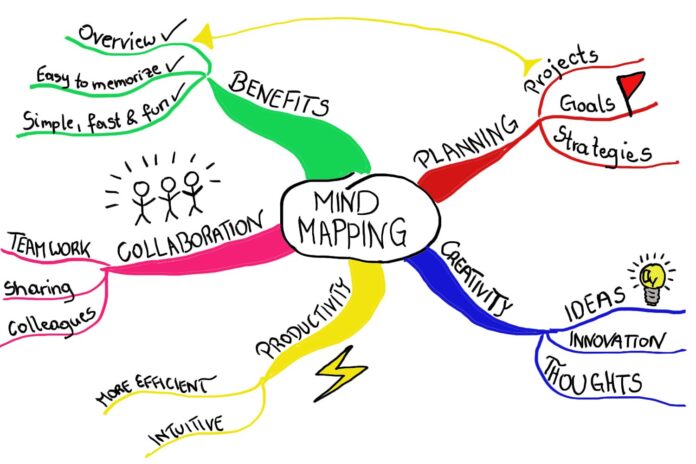In an era defined by rapid technological progress and global competition, the imperative for innovation has never been more pressing. While the concept of innovation might seem abstract, its effects are tangible, palpable, and often transformative.
Innovation hacks provide shortcut techniques to kindle this transformative spark. These hacks help individuals and businesses traverse the challenging path to novel ideas with a clear roadmap.
This guide will uncover these hacks, offering insights and techniques that can help you harness creativity and bring revolutionary ideas to the table.
Mind Mapping for Creative Ideation

Mind Mapping is not just a tool; it’s a voyage into the depths of your thoughts. At its core, a mind map is a diagram used to visually represent ideas branching from a central concept.
The magic unfolds as you begin to connect related ideas, spotting patterns and relationships that might otherwise remain obscured.
- Start with a Central Idea: The epicenter of your mind map. This could be a problem, a concept, or even a single word.
- Branch Out: From the central node, create branches representing primary thoughts or ideas.
- Add Sub-branches: Diving deeper, expand upon each primary branch.
- Use Colors and Images: These enhance memory recall and stimulate creativity.
- Seek professional help: Outlets such as InventHelp can be of great help when the idea is just born.
Consider Tony Buzan, the father of mind mapping. He used this technique to pen numerous books and inspire countless others to explore the power of their minds.
Design Thinking: A Blueprint for Innovation
Design thinking is more than a method; it’s a mindset. Centered on empathy, it’s about solving problems from the user’s perspective. Here’s how you can harness its power:
- Empathize: Understand user needs by immersing yourself in their world.
- Define: Distill these insights into a clear problem statement.
- Ideate: Generate a myriad of solutions.
- Prototype: Turn ideas into tangible models.
- Test: Take feedback, refine, and iterate.
When IBM applied design thinking, they transformed from a hardware company to a design-centered corporate behemoth.
Brainstorming Techniques for Creative Sparks

Traditional brainstorming—where groups assemble to generate ideas—has its merits, including fostering team unity and harnessing collective intelligence.
However, newer methods like brainwriting introduce a preliminary stage where individuals jot down their thoughts privately.
This not only avoids premature judgment but also removes the shackles of groupthink, ensuring diverse perspectives.
Digital platforms, like Miro, further enrich the process, providing virtual spaces for real-time, synchronized brainstorming, accommodating remote teams and diverse geographical locations.
Key to a successful session is the ambiance: create a welcoming environment where imagination runs wild and judgment is reserved for later stages. For more techniques please visit this website.
The Power of Cross-Pollination
In a world where boundaries are increasingly blurred, why should ideas remain siloed? Cross-pollination, or the fusion of concepts from diverse fields, has yielded astounding results.
Take the smartwatch—a seamless integration of timekeeping and communication. Collaborations like Nike and Apple, or Uber’s diversification into food delivery, are classic examples of industries overlapping to birth pioneering concepts.
Inspiration is omnipresent—it could be in a book, a nature walk, or even a casual conversation. The challenge is to connect the dots, bringing disparate ideas together into an innovative concoction.
Embracing Constraints: Innovation Through Limitations
Constraints, traditionally seen as hurdles, are transforming into launchpads for creativity. When options become limited, it forces a unique brand of resourcefulness, making one dig deeper and think differently.
Post the 2008 financial crisis, financial tech evolved, birthing groundbreaking innovations like digital wallets and cryptocurrencies. Similarly, Twitter’s 280-character limit wasn’t a restriction; it was a challenge that paved the way for concise, impactful narratives.
Rather than viewing limitations as obstacles, reframe them as puzzles waiting to be solved. And in that puzzle-solving process, innovation thrives.
Crowdsourcing Ideas for Innovation

In the age of interconnectedness, why limit innovation to a room? Crowdsourcing democratizes the idea generation process.
Platforms like Kickstarter harness collective financial power to bring dreams to life, while InnoCentive sources global brainpower to solve challenges.
A standout example is Lego Ideas. Here, fans from around the world suggest novel product designs, underscoring the potency of pooled creativity. It’s a global think tank, where the crowd, with its diverse perspectives, becomes the prime innovator.
Customer-Centric Innovation: From Feedback to Ideas
Businesses exist to serve customers, and in these customers lie a treasure trove of insights. Tools like surveys, feedback forms, or even casual conversations can unravel invaluable perceptions about products or services. One exemplary implementation of this is Netflix’s recommendation engine. Driven by user viewing habits, it provides personalized suggestions, transforming the viewer experience. By listening intently and then innovating based on customer feedback, businesses can craft solutions that resonate deeply with their target audience.
Innovation Metrics: Measuring and Managing Success
The journey of innovation, while filled with uncertainties, is not a shot in the dark.
By leveraging Key Performance Indicators (KPIs) such as Return on Innovation Investment or Time to Market, businesses can gauge the efficacy of their endeavors.
Google’s famed “80/20” rule, which empowers employees to allocate a fifth of their working hours to passion projects, exemplifies how structured frameworks can coexist with creative freedom.
Measuring and managing these innovative efforts ensures resources are optimally utilized and objectives are met.
Innovation in the Digital Age: Leveraging Technology

The wave of digitalization is more than mere technology adoption; it’s a reimagining of how things function.
AI-powered chatbots revolutionize customer interactions, blockchain promises unparalleled supply chain transparency, and IoT turns homes into intelligent sanctuaries.
Pioneers like Tesla stand out—not just for their technological prowess but for their vision of sculpting tomorrow. Leveraging technology, they’re not just staying in the game; they’re redefining it.
Innovation Culture: Fostering a Creative Environment
While strategies and tools are vital, true innovation stems from culture—the invisible hand guiding behaviors and mindsets.
Spaces like Google’s vibrant campuses or Pixar’s artistically charged studios reflect how physical environments can inspire and nurture creativity.
Beyond aesthetics, it’s about fostering a spirit of collaboration, encouraging risk-taking, and celebrating both successes and failures as learning opportunities.
Fail Forward: Learning from Innovation Mistakes

The path of innovation, while exhilarating, is riddled with pitfalls. Apple’s Newton or Google Glass might not have hit the mark, but they provided invaluable learnings.
It’s crucial to remember that every misstep is a step forward in understanding what doesn’t work. Embracing a growth mindset transforms failures from endpoints to inflection points—springboards to greater heights.
Harness these hacks, immerse in the thrilling voyage of innovation, and gear up to reshape the world, one groundbreaking idea at a time.








